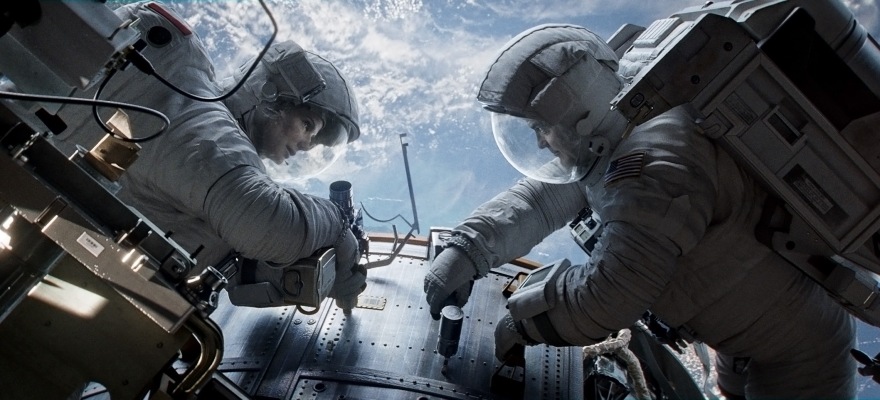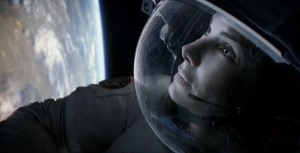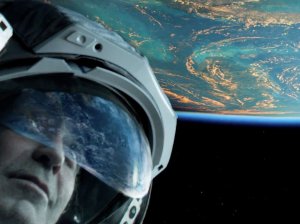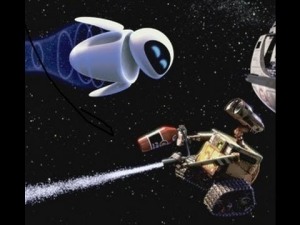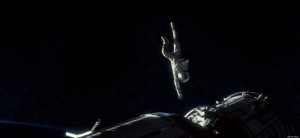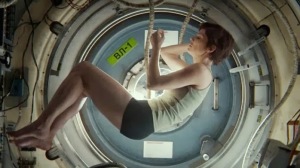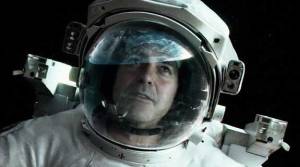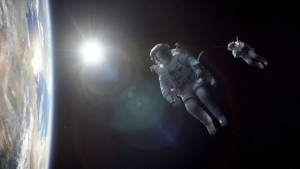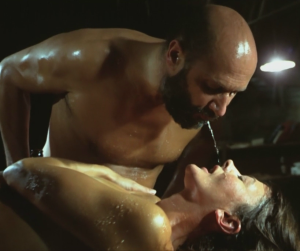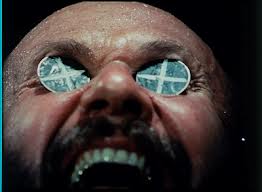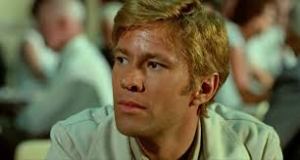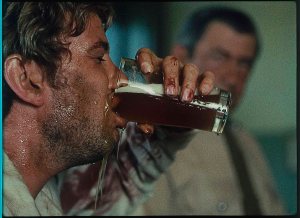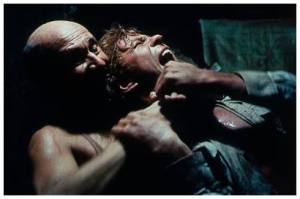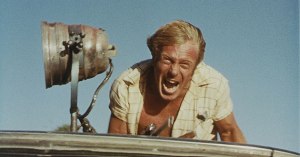I had the opportunity to watch Gravity this weekend with Robby Stephenson, Senior Engineer in the Mechanical Engineering Division at NASA’s Jet Propulsion Laboratory. Afterwards we talked about the science on display in the film, what they got right and what seemed off. More importantly, we talked about how these things affected the story.
We also poked fun at George Clooney a little bit, just because.
Joining us in the conversation was Regan Hutson, a photographer and science buff who had some great things to contribute.
Warning: This article is for folks that have already seen the movie. We jump around a lot in the chronology of the movie and give major SPOILERS.
James Roland: Okay, tell us what was fake. Or what stood out to you, not just the science but whatever.
Robby Stephenson: I’m not usually an emotional person for a movie, but my emotions were all up and down. In a regular blockbuster or something, it’s like “yeah, things are blowing up but they’re not in danger” but I guess the realism was just so good … I was getting tense and I would catch myself not breathing and gripping my arm rests.
James: I did that too and it was my second viewing.
Regan Hutson: There were points with all the debris that it almost felt like a Michael Bay film.
James: Like the second time the debris comes she doesn’t get hit at all but everything around her gets destroyed.
Regan: Right.
James: Which they kind of had to do because if that capsule even gets pierced once she’s be out of commission, so they kind of had to fake it.
Robby: The biggest thing that sticks out to me was when Sandra Bullock lets George Clooney go … there’s nothing that pulls him away. They’re in space, they’re just floating. They’re not on the Titanic!
James: I was curious about that, because they stop sharply …
Robby: Yeah, so once you stop, you’re stopped. Nothing’s gonna make you move any more.
James: Clooney says the ropes are too loose and then you see her giving way …
Robby: But there’s nothing pulling on him.
James: My thought was they did such a good job with the physics in the beginning …
Robby: I had the exact same thought. When they were on the space shuttle everything looks really good, with the bolt floating away and her twisting around … but once they got on the space station I felt like the quality suffered a little bit.
James: A little bit, yeah.
Robby: All they would have had to do was have something hit the space station and it was rotating, then you’d have the centrifugal force. That would have been enough to pull him away. But it was fairly stable from what I could see.
James: Yeah.
Robby: But they got a lot of stuff right.
James: What about the fire, did that seem realistic to you?
Robby: Yeah, fire is one of the biggest dangers up there and they’ve had a couple of small ones.
James: And it’s orb-like?
Robby: Yeah, you should watch some of the videos they have with the physics of flame and candles and water in zero gravity.
James: Someone pointed out to me that even though you have pressure from your body, your intestines are used to the pull of gravity so they are affected as well. They’re essentially floating inside of you, something I hadn’t thought about.
Robby: Space is a constant feeling of falling. It’s like going down the side of a roller coaster. Something like half to two thirds of astronauts get sick, they expect it. I think they don’t plan anything for their first day up there.
Regan: One of the things I couldn’t get out of the back of my head was out of the entire international space station … nothing breached it. So the entire thing is still full of oxygen. Which is kind of necessary for there to be some hope for her to survive, but it seems really, really unlikely.
James: Unless there was a hose inside she could plug into for oxygen, but I don’t know if that even exists.
Robby: Yeah, I don’t know a lot about the suits. But I do know you can’t take them off that fast.
James: That’s a good example though of where they needed to fake some things for the sake of story. Later she sees she has seven minutes before the debris comes again, and in the next scene she’s outside the ship and I’m thinking “just seven minutes to get the suit on and get outside, you’re gonna rush and forget something.”
Robby: Yeah, everything was really compressed. They don’t do anything fast.
James: To me, stuff like that is a given in a movie. If you go in nitpicking that then you’re missing the point.
Robby: I’ve observed space walks and it’s corn growing … I mean, it takes two hours to do anything. You want to see the highlights!
James: It’s interesting. You could argue that because the whole movie evolves (or devolves, depending on your world view) into a story of faith, that as she goes along it gets more and more incredible and less realistic. I don’t know if that’s intentional or if I’m just reading into it. Like, what do you feel about the re-entry scene? Sandra Bullock’s character says she has a fifty-fifty chance, but I think I remember learning it’s a lot less than that … isn’t there a really narrow window where you won’t burn up?
Robby: Yeah, there really is. I think the Soyuz are fairly foolproof, I mean they’re Russian so they’ve been flying them for 40 or 50 years. It’s an automated system. But you gotta hit a narrow window and get everything oriented the right way.
Regan: Wasn’t there a mission where just a small piece of damage to the shielding caused the entire thing to collapse during re-entry? Just knowing that, the probability seem very low [she’d survive]. But I guess the capsule was internal through the whole thing until she starts to re-enter so the shielding could have been protected.
James: My take on it was that wasn’t how it was supposed to go down, but because it was already falling she went down in the wreckage and then it broke apart around her. But then she was spinning and it righted itself, so I’m assuming that’s automated.
Robby: It is designed to right itself, a heavy side down kind of thing.
Regan: So the aerodynamics keep it oriented so the shielding carries the brunt of the heat.
James: What did you all think about the fire extinguisher scene? In a way I think the filmmakers fought against themselves because they did such a good job showing how fast they are moving and how hard it is to grab on to another moving object that it ultimately seems impossible.
Regan: I think the question in that scenario is would a fire extinguisher have enough thrust?
Robby: At the end when she ran out, she threw the can away from her to get a little extra thrust, I thought that was a nice touch.
James: So that would actually work?
Robby: Yeah, it’s a change in momentum. You can throw anything and you’d get somewhere.
James: When she launches from the ISS and goes to the Chinese space station and makes the leap … presumably that’s incredibly fast, right?
Robby: If you think about it … it took her about an hour to get there so … orbital dynamics are funky. Once you point in the direction you’re going you just coast. You see that when the two astronauts are tethered together.
James: Is there a certain amount of friction from solar winds?
Robby: There’s enough friction that you have to care about it when it comes to satellites, but it’s minimal. It would take like a month to slow down.
James: So how fast would you say that they were going?
Robby: Relative to each other? They’re all going 20,000 miles an hour. But the relative rate … a couple miles an hour? One to ten miles per hour, something like that? Which is enough to jerk your arm pretty good, imagine trying to catch someone rolling down a hill.
Robby: So what happened to the Chinese astronauts? Did they evacuate?
James: I assumed so, but why did they leave an escape pod?
Regan: Wouldn’t you want any evacuation system to be redundant in case the first didn’t work?
James: Good point. As near as I can tell, because I’m not an expert, all the points where they fudged the science were for story points.
Robby: Yeah.
James: Like when she gets thrown off at the beginning, the chances of him finding her seem so slim.
Robby: Yeah, you couldn’t see anything out there.
Regan: Maybe the way she was spinning she was the only intermittent light source.
Robby: Yeah.
Regan: One thing that bothered me … do you remember the Radiolab episode where they’re talking to the astronaut, and he talks about how black the shadows are? Having a photography background and paying attention I kept thinking “there’s definition in those shadows, that shouldn’t happen!”
James: But that’s just such an amazing opening and they have to get themselves out of it somehow. Probably every step of the way the filmmakers would ask “can we do this?” and the science adviser would say “no” and they’d say “well … we’re going to do it anyway.”
Robby: They don’t really have a jet pack like that, though. I mean, they have maneuvering units but you don’t have nearly that capacity for flying around. I don’ t even think they use them anymore.
James: The key word is “prototype”, George Clooney calls it a prototype.
Robby: Yeah, they throw that in there to justify it.
James: My thought was that it’s such a big deal to un-tether, what if the jet pack failed? But that’s sort of George Clooney’s character in this, he’s really out there. Kind of one note. It’s maybe the most one note character he’s played … when they get to the dream-version of him, there isn’t even any hyperbole, that’s just him!
Robby: I have to admit (regarding the dream sequence), my first thought was “he couldn’t have done that, that’s really stretching it!”
James: And at first you can’t see the astronaut’s face, so you think maybe it was another survivor or a rescue mission … then they open the hatch.
Robby: And you can’t do that!
James: And I thought “are they really doing this, going for a bleak, dark humor ending?” He climbs inside, looks at her dead body, and goes, “whoops.” At first you can’t figure out what’s going on, then as he starts to talk it dawns on you that there’s only one option … and it’s cheesy.
Robby: Yeah. I half expected her daughter to appear.
James: She’s hanging outside the window, “Mom! Mom!”
*Laughter*
James: From then until the end is where they just pour on the cheese. I actually felt the earlier stuff is more powerful. When they’re just floating by and he’s talking to keep her sane, and she has that little monologue about her daughter dying. It’s so incredible.
Regan: I think one of the things I appreciated because it was in the same tone but it doesn’t hit you over the head as much was when she gets to the ISS and she takes off her spacesuit and just floats there.
James: So beautiful.
Regan: The shot turns into her as a fetus in the womb, down to even the umbilical cord!
James: And it’s a shedding of the cocoon with the space suit … I felt that shot was powerful and earned. I thought the one at the end that didn’t work as well, because it was kind of a repeat thematically, was the “evolution” shot when she crawled out of the water.
Regan: Her struggling to get up on her feet was pretty justified.
James: True, but the angle they chose to film it was very specific.
Robby: Then they shoot up at her as she staggers off.
James: You half expect to see a monolith and she starts dancing around it with a bunch of apes. It’s a beautiful shot, but it seemed a little on the nose to me.
Regan: That’s funny, that association didn’t occur to me until you said it.
James: I’ve heard other people talk about it, but maybe it’s more subtle than I thought.
Robby: I just thought it was cool they acknowledged how hard it is to walk after being in space because of the muscle loss.
James: I love when Sandra Bullock laughs because of the irony of the moment. She has some good dialog and some cheesy dialog throughout the movie, but she owns all of it. There’s so much talking to herself.
Robby: That’s got to be hard for an actor.
James: It is. And her character changes SO much by the end, she’s great.
Regan: It’s like a miniature version of Castaway with a female lead once George Clooney is gone.
James: George Clooney is Wilson?
Robby: “I’m coming for you!!!!!”
James: She goes and buys a cardboard cutout of him when she gets home.
Regan: So that’s why his character’s so one-dimensional.
Robby: There it is!
James: Wow. Ouch.
Regan: I wondered about when they get back to the space shuttle after everything’s destroyed, it didn’t make sense to me that there would be things floating around inside. I thought every loose object would have been evacuated when the hull was breached.
Robby: They do keep things tied down.
Regan: But there were little things like the Marvin the Martian doll and pens, all floating freely.
Robby: Yeah, so that should have been blown out, I think you’re right. I will say this, the realism that they miss, which most people won’t notice … is the orbital dynamics. The space stations aren’t all that close to each other. The Hubble is in a completely different orbit. And orbital dynamics are weird. I took classes in this. ‘Cause to go faster you first slow down and get in a lower orbit, then speed up and get to a higher orbit. When you trade altitude for speed, it’s all completely counter-intuitive. So flying an approach vector, when they dock to the space station or something, it’s very non-intuitive.
James: So you go faster when you’re lower? In the same way that the outer edge of a record is moving at a different rate of speed from the center?
Robby: It’s the reverse of that, because on the outer edge of a record you’re going faster, but in space when you’re in a higher orbit you’re actually going slower. So to go from a low orbit to a high orbit you speed up, but by the time you get to the other side of the orbit you’re going slower and you would shoot your rocket in the opposite direction of what you might think. It’s weird.
James: Wow.
Robby: So they dock from beneath, from the Earth direction, but it’s counter-intuitive, you can’t just point where you want to go and shoot your rocket.
James: And [the space stations are] at different altitudes.
Robby Yes. But even if they were, you can’t just speed up and go there, because as you speed up you’ll change orbit.
Regan: It make sense to me that something orbiting at a lower altitude needs to be moving more quickly so that the centrifugal force is countering gravity, but if you are at one orbit and you just push yourself down, are you going to increase in speed for some reason? Or do you have to push yourself to increase speed so that your orbit doesn’t degrade?
Robby: The weird thing is that it’s a little bit of both. So if you’re in a circular orbit your speed is the same everywhere. But if you’re in an elliptical, if you go oval, your speed varies quite a bit.
James: In the movie they make it seem like they could just shoot around and visit each other up there.
Robby: And that was definitely necessary for part of the story.
Regan: We’ve all been watching movies set in the future where they fly around in space like they’re in planes.
James: I’m curious. Everyone’s been talking about the realism and all the things they can find wrong … but I don’t remember people talking this much about the realism of Apollo 13 when it was released, do you?
Regan: Oh yeah, I do.
Robby: I read things about how they had the wrong patch on their suits!
Regan: Do you mean picking it apart the same way?
James: Yes. Or lauding it.
Regan: I remember seeing an interview with Ron Howard where he talked about the premier and how they invited folks that worked on the Apollo missions and how they couldn’t believe some of it was done with computer.
James: Not to knock Gravity at all, but when everyone was talking about how realistic it was I just thought “well, Apollo 13 did it years ago.” But they also had actual events to build on, Gravity is a fictional event.
Robby: That debris problem is very real up there, though. There’s lots of junk up there. And NORAD has to track everything down to the size of a basketball or something like that. And every now and then they have to move the space station out of the way to keep it from getting hit.
James: Does the Earth’s rotation affect all this? Can you put something in orbit counter to the Earth’s movement?
Robby: Yes, but it just takes a whole lot more fuel. Launching eastward is a whole lot easier than launching westward.
James: So [in the movie] the debris is traveling the same direction as they are.
Robby: If you have an explosion it’s going all over the place. The movie said something about the debris moving at 20,000 mph relative speed, which means it’s actually going about 50,000, I don’t know if it could have gotten that fast. But if you go look at the Endeavor space shuttle down at the science center and look at the windshield, it’s pitted. That’s specks of dust going 20,000 miles per hour.
James: Seeing it a second time I was determined to figure out how they did certain shots, but it’s a testament to the story that I got sucked in again and forgot to do that.
Robby: They got the northern lights in there. That made me catch my breath. A lot of astronauts talk about seeing that. *pause* It really is a great movie.
James: Despite how terrifying it is, there’s gonna be a huge influx of applications to NASA.
Related articles
- Here’s what ‘Gravity’ gets right and wrong about space (washingtonpost.com)
- Copernicus On The Science Of GRAVITY!! (aintitcool.com)
- George Clooney: ‘Gravity’ is an Argument for 3D (thewrap.com)
